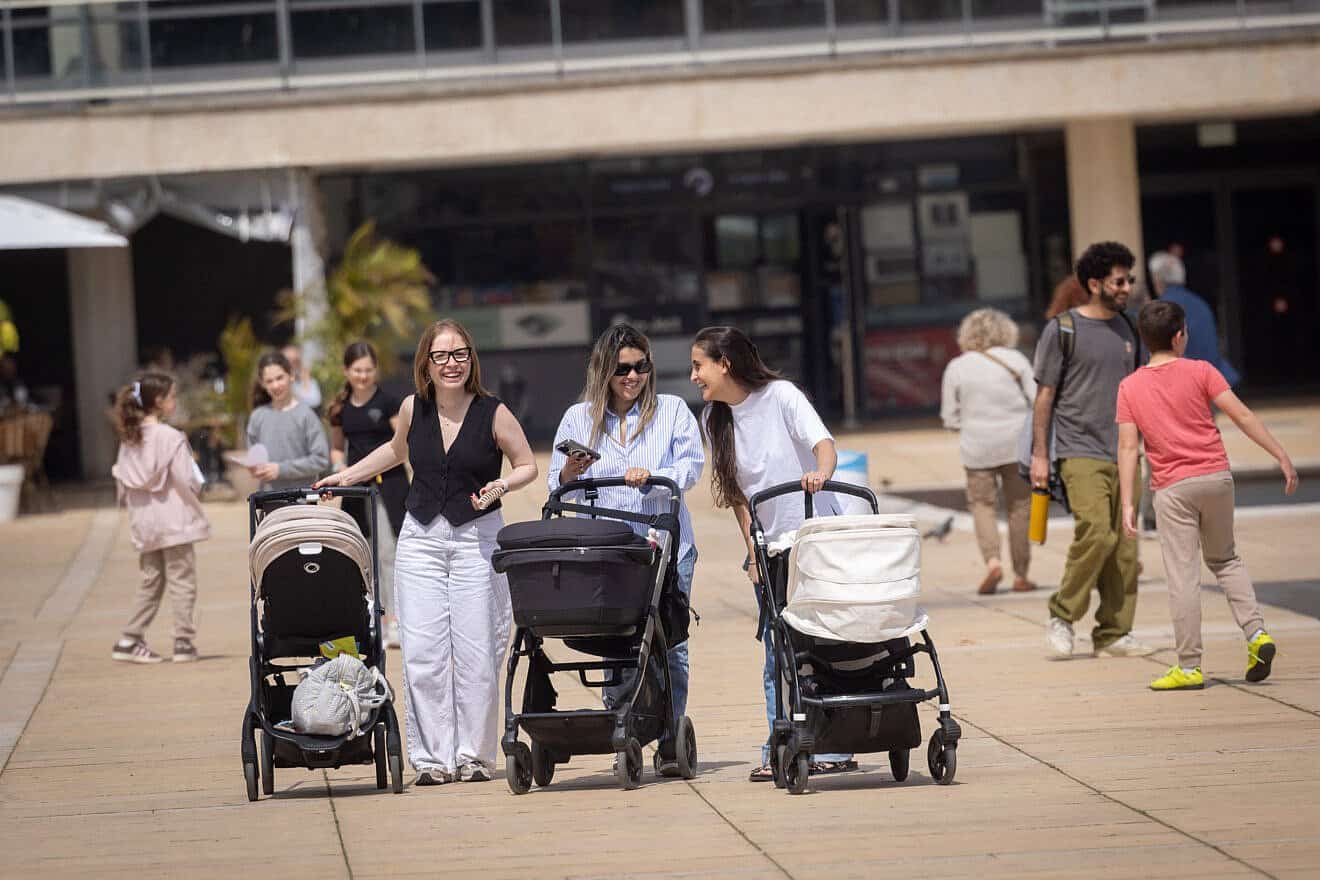by Hili Yacobi-Handelsman
A dramatic decline sees Muslim fertility down to 2.75 children per woman, while Jewish women reach 3.06.
 |
Mothers and their babies at Habima Square in Tel Aviv, March 25, 2025. Photo by Miriam Alster/Flash90. |
A groundbreaking demographic shift has emerged in Israel since 2001, with 2024 data from the Central Bureau of Statistics revealing that Jewish women’s fertility rate, at 3.06 children per woman, now exceeds that of Muslim women, at 2.75 children per woman.
The Muslim population, totaling around 1.809 million, or 18.0% of Israel’s residents, increased by 2.0% in 2024, gaining approximately 35,100 people since the end of 2023. While this growth outpaces the Jewish population’s 1.1% rise, it reflects a major slowing down compared to the 3.8% growth rate in 2000.
Meanwhile, the Christian population shrank by 0.2%, and the Druze population dropped by 0.9%.
Nearly half of Muslims live in northern Israel, with 33.8% in the Northern District and 13.1% in the Haifa District. Another 22.1% reside in the Jerusalem District, 18.7% in the Southern District, 10.9% in the Central District, and 1.4% in the Tel Aviv District.
Roughly 43% of Muslim Israelis live in the 10 localities with the largest Muslim populations. Jerusalem has the most, with 386,300 Muslims, or 21.4% of the national Muslim population and 36.9% of the city’s residents. The Negev Bedouin city of Rahat follows, with 77,900 Muslims comprising 99.5% of its population. Other notable Muslim communities include Umm al-Fahm (60,100 residents) and Nazareth (57,000 residents).
The Muslim population remains young, with 31.2% aged 0–14 and only 5.1% aged 65 and older. Among those aged 45–49, 9.2% of Muslim women are unmarried, compared to 4.7% of men. About 27% of Muslim-headed households include six or more members, compared to 10% of Jewish-headed households. Life expectancy in 2024 stood at 77.2 years for Muslim men and 82.9 years for Muslim women.
During the 2023/24 school year, 403,800 Muslim students attended primary and post-primary schools, with 6,900 in Hebrew-language schools and the rest in Arabic-language schools.
In 2022/23, 74.0% of Muslim students who took matriculation exams qualified for a high school graduation diploma, and 48.3% met university admission standards, nearly matching the 46.8% from the previous year. Muslim women were far more likely to pursue bachelor’s degrees (41.8%) than Muslim men (20.2%).
In the 2022/23 school year, 3,100 Muslims enrolled in pre-academic programs, representing 27.0% of such students. In 2023/24, 49,800 Muslims studied in higher education, comprising 16.4% of all students. That year, 11,800 Muslims received academic degrees, accounting for 13.0% of all degree recipients.
In 2024, labor force participation among Israeli Muslims aged 15 and older was 48.2%; 62.1% for men and 34.4% for women. In 2023, approximately 307,600 Muslims were registered with the Ministry of Welfare and Social Security, out of 1.18 million individuals. The disability registry included 179,100 Muslims, out of 1.163 million people.
In 2022, Muslims faced a criminal conviction rate 2.9 times higher than non-Muslims, at 579 per 100,000 people compared to 200 per 100,000. Common offenses included public order violations (28.2%), crimes against persons (22.4%) and property crimes (19.7%).
In 2024, 881,277 Israeli Muslims held driver’s licenses, making up 16.8% of all drivers, with 41.5% being women. That year, 3,315 Muslims were injured in road accidents, representing 22.9% of all casualties, exceeding their 16.9% population share. Of these, 140 were killed, 690 were seriously injured and 2,485 sustained minor injuries.
Originally published by Israel Hayom.
Hili Yacobi-Handelsman
Source: https://www.jns.org/jewish-womens-fertility-rate-outpaces-muslims-in-israel/
No comments:
Post a Comment